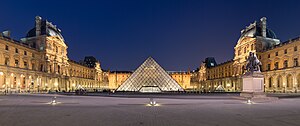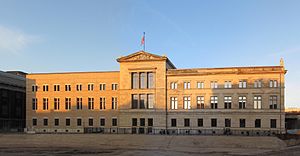Art History Epsode 1:
400 C.E. Ancient Cultures
| Courtyard of the Museum of Louvre, and its pyramid. (Photo credit: Wikipedia) |
with rock crystal, magnesite, and copper/arsenic inlay for the eyes and wood for the nipples, f
ound in Saqqara (Musée du Louvre, Paris)
2. House Altar depicting Akhenaten, Nefertiti and Three of their Daughters, limestone, New Kingdom, Amarna period, 18th dynasty, c.1350 BCE (Ägyptisches Museum/Neues Museum, Staatliche Museen zu Berlin)
| Exterior of the Neues Museum in Berlin. (Photo credit: Wikipedia) |
4. Victory Stele of Naram-Sin, Akkadian, pink limestone, 2254-2218 B.C.E. (Louvre, Paris)
This monument depicts the Akkadian victory over the Lullubi Mountain people. In the12th century B.C.E., 1,000 years after it was originally made, the Elamite king, Shutruk-Nahhunte, attacked Babylon and, according to his later inscription, the stele was
taken to Susa in what is now Iran.
| The British Museum, Great Court (Photo credit: Wikipedia) |
often inscribed with text or relief carving.
5. Law Code Stele of King Hammurabi, basalt, Babylonian, 1792-1750 B.C.E. (Musée du Louvre, Paris)
A stele is a vertical stone monument or marker often inscribed with text or with relief carving.
6. Ramesses II, Herakleopolis (Temple of Harsaphes), New Kingdom, Egypt, c. 1250 B.C.E. (University of Pennsylvania Museum of Archaeology and Anthropology)
7. Kouros (youth), Archaic Greek, Attic, ca. 590--580 B.C.E. (Metropolitan Museum of Art)
8. Krater, Terracotta, 42 5/8 in. height (108.25 cm), ca. 750--700 B.C.E., Attic
Attributed to the Hirschfeld Workshop (Metropolitan Museum of Art)
9. Unknown, Mixing Vessel with Odysseus Escaping from the Cyclops's Cave, 550-500 B.C.E.
| Metropolitan Museum of Art entrance NYC (Photo credit: Wikipedia) |
(420 linear feet of the 525 that complete the frieze are in the British Museum)
11. Battle of the Lapiths and Centaurs, Parthenon Metopes,
south flank, marble, c. 440 B.C.E. (British Museum, London)
12. Phidias (?), Sculpture from the East Pediment of the Parthenon, marble, c. 448-432 B.C.E. (British Museum, London)
13. Caryatid (South Porch) and Ionic Column (North Porch), Erechtheion on the Acropolis, Athens, marble, 421-407 B.C.E. (British Museum, London); Mnesicles may have been the architect.
14. Unknown sculptor, Venus after the Greek original by Praxiteles from the 4th century B.C.E., Roman, 175-200 C.E. (Getty Villa)
15. Dying Gaul, ancient Roman marble copy of a lost bronze Greek sculpture, c. 220 BCE
16. Nike (Winged Victory) of Samothrace, Lartos marble (ship) and Parian marble (figure), c. 190 B.C.E. 3.28m high (Musée du Louvre, Paris). The sculpture was unearthed in 1863 after its discovery under the direction of Charles Champoiseau, the French Vice-Consul to Turkey.
Please note that the theoretical reconstruction of the Nike as a trumpeter mentioned in the video has been largely abandoned; the monument is now thought to have been part of a fountain possibly commemorating a naval victory.
17. Temple of Portunus (formerly known as, Fortuna Virilis), travertine, tufa, and stucco, c. 120-80 B.C.E., Rome
Portunus was the Roman god of gates, keys and ports (this was adjacent to a port on the Tibor river). The temple is thought to have survived because it was converted to a church, Saint Mary of Egypt, in 872 C.E. Please note that this recording contains traffic and wind noise due to the busy and open location of the Temple of Portunus.
18. Arch of Titus, originally Pentelic marble, early 19h-century restoration is in travertine,
c. 81 C.E. (Via Sacra, Rome)
The surviving original inscription reads: SENATVS POPVLVSQVE ROMANVS DIVO TITO DIVI VESPASIANI F[ILIO] VESPASIANO AVGVSTO Senate People of Rome to the divine Titus Vespasian Augustus son of Vespasian
19. Colosseum (Amphitheatrum Flavium) c. 70-80 C.E., Rome
20. Equestrian Sculpture of Marcus Aurelius, bronze, c. 173-76 C.E., (Capitoline Museums, Rome).
The original location of the sculpture is unknown though it had been housed in the Lateran Palace since the 8th century until it was placed in the center of the
Piazza del Campidoglio by Michelangelo in 1538. The original is now indoors for
purposes of conservation. Marcus Aurelius ruled 161-180 C.E.
21. Arch of Constantine, 315 C.E., Rome
22. A Tour through Ancient Rome in 320 C.E.
A project between Khan Academy and Rome Reborn - with Dr. Bernard Frischer
23. A tour of Hadrian's Villa with Dr. Bernard Frischer
A virtual tour of Hadrian's Villa using a 3D digital model of the villa created under the direction of Dr. Bernard Frischer.
The ruins of Hadrian's Villa, in the town of Tivoli, near Rome, is spread over an area of approximately 250 acres. Many of the structures were designed by the Emperor Hadrian who ruled from 117 until his death in 138 C.E. This virual rendering is based on current archeological research and has been created in consultation with art historians, archaeologists, and museum curators with expertise in this area. Please note, a few features are necessarily assumptions based on the best available evidence.
Speakers: Dr. Bernard Frischer and Dr. Beth Harris
24. Standard of Ur, c. 2600-2400 B.C.E., 21.59 x 49.5 x 12 cm (British Museum)
25. Thutmose, Model Bust of Queen Nefertiti, New Kingdom, 18th dynasty, c. 1340 BCE, limestone and plaster (Egyptian Museum and Papyrus Collection/Neues Museum, Berlin)
26. Painted Garden, Villa of Livia, fresco, 30-20 B.C.E. (Museo Nazionale Romano, Palazzo Massimo, Rome)
Plant species include: umbrella pine, oak, red fir, quince, pomegranate, myrtle, oleander, date palm, strawberry, laurel, viburnum, holm oak, boxwood, cypress, ivy, acanthus, rose, poppy, chrysanthemum, chamomile, fern, violet, and iris.
27. Apollonius, Boxer at Rest, c. 100 B.C.E., bronze, Palazzo Massimo, Museo Nazionale Romano, Rome
28. Ara Pacis Augustae (Altar of Augustan Peace), 13-9 B.C.E.
29. Polykleitos, Doryphoros (Spear-Bearer), Roman marble copy after a Greek bronze original from c. 450-440 B.C.E. (Museo Archaeologico Nazionale, Naples)
30. Ancient Greek Temples at Paestum:
Hera I, c. 560-530 B.C.E.
Hera II, c. 460 B.C.E.
Temple of Minerva, c. 500 B.C.E.
31. A conversation between Dr. Beth Harris and Dr. Steven Zucker in front of an
Attic black figure amphora by Exekias (potter and painter), c. 540-530 B.C.E., 61.1 cm high, found Vulci (Gregorian Etruscan Museum, Vatican City)
32. Digging Through Time
A conversation with Dr. Darius Arya and Dr. Beth Harris
33. East and West Pediments from the Temple of Aphaia, Aegina, c. 490-480 B.C.E. (Glyptothek, Munich)
34. Barberini Faun, c. 220 B.C.E. (Glyptothek, Munich)
35. The Colossus of Constantine, c. 312-15, Palazzo dei Conservatori, Musei Capitolini, Rome
A conversation between Dr. Beth Harris and Dr. Steven Zucker in front of the Colossus of Constantine.
36. Alexander Mosaic, c.100 B.C.E., copy (Pompeii) of a lost Greek painting, c. 315 B.C.E., Archaeological Museum, Naples
37. Myron, Discobolus (Discus Thrower), Roman copy of an ancient Greek bronze from c. 450 B.C.E. (Palazzo Massimo alle Terme)
38. Maritime Theatre at Hadrian's Villa, Tivoli, Villa begun in 117 C.E.
39. Battle of the Romans and Barbarians (Ludovisi Battle Sarcophagus), c. 250-260 C.E. (Museo Nazionale Romano-Palazzo Altemps, Rome)
40. Veristic male portrait, early 1st Century B.C.E., marble life size (Vatican Museums, Rome)
42. A conversation between Dr. Beth Harris and Dr. Steven Zucker in front of Portrait Head of Queen Tiye with a Crown of Two Feathers, c. 1355 B.C.E., Amarna Period, Dynasty 18, New Kingdom, Egypt, yew wood, lapis lazuli, silver, gold, faience, 22.5 cm high (Egyptian Museum and Papyrus Collection at the Neues Museum, Berlin
44. Athanadoros, Hagesandros, and Polydoros of Rhodes, Laocoön and his Sons, early first century C.E., marble, 7'10 1/2" high (Vatican Museums)
45. Lysippos, Farnese Hercules, 4th century B.C.E. (later Roman copy by Glycon)(Archaeological Museum, Naples)
46. Exekias, Dionysos Kylix, c. 530 B.C.E. (Antikensammlungen, Munich)
47. Jeweled upper cover of the Lindau Gospels, c. 880, Court School of Charles the Bald, 350 x 275 mm, cover may have been made in the Royal Abbey of St. Denis (Morgan Library and Museum, New York)




